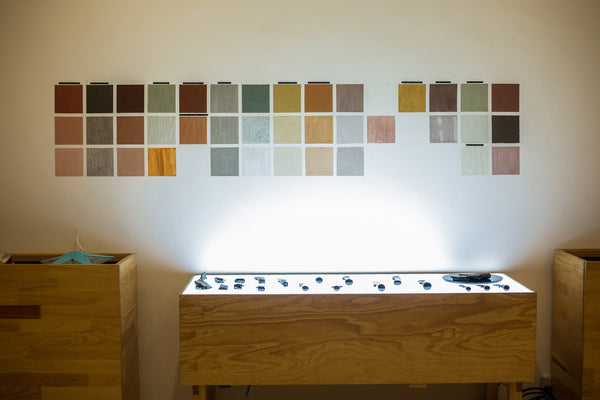
ÍNDICE DE MATERIALES

Históricamente, algunos materiales han sido más apreciados que otros por valores culturales, por su marketing o por gustos individuales. Con la urgencia de cuestionar nuestra huella ecológica, comenzamos a escuchar que se describían algunos materiales como mejores o peores para el entorno. Nos dio mucha curiosidad entender estos calificativos y queríamos saber más sobre materiales para tomar mejores decisiones en el futuro.
Es por esto que cuando nos invitaron a realizar una exposición y un programa de actividades en la Sala Educativa del Museo Tamayo llamado INDICE DE MATERIALES, girando entorno a la exhibición “Ceremonia” de Claudia Fernandez, no dudamos en decir que sí. 
Se nos hizo muy relevante la forma en la que la artista presentó el trabajo de artesanos Mexicanos, ligando el uso de los materiales y las formas de trabajar, al territorio y la cultura de las comunidades. Cada proceso tenía una historia y una localidad.
Para aprender más acerca de los usos de materiales actuales, vimos que debíamos aprender sobre procesos tradicionales y las relaciones directas o manuales de cada artesano con su pieza. Invitamos a algunos maestros para compartirnos su proceso mediante talleres.
Cerramos con una serie de preguntas en ingeniería inversa para dialogar acerca de los objetos expuestos en el Tamayo.
1. ORÍGEN
¿De dónde vienen los materiales usados en ese objeto?
¿De qué territorio, bioma o capa de la tierra?
2. CLASIFICACIÓN Y CARACTERÍSTICAS
Si es Biótico ¿A qué reino biológico le pertenece?
Si es Abiótico ¿En qué categoría de materiales está?
¿Qué características particulares tiene?
3. PROCESO DE TRANSFORMACIÓN
¿Cómo se transforman los materiales para crearlos?
¿Qué herramientas se usan?
¿Qué tipo de fuerza o energía se les debe ejercer?
¿Qué elementos naturales participan?
(Tierra, Viento, Agua y Fuego)
4. USO
¿Para qué se hace el objeto?
¿Cuál es el uso que se le da?
¿Cuánto tiempo puede durar su uso?
¿Se puede reciclar?
Estas preguntas nos han ayudado a pensar en el diseño de un objeto, tanto para hacer piezas únicas como para los productos que replicamos en serie.



With the shared feeling of responsibility of how we are affecting the environment with what we consume and what we throw away, we began an ongoing research of materials and their lifespan. As product designers, we have a major role in this process of transformation; current design has to consider not only the relationship of materials with the users but also their relationship with the global environment.
Historically, some materials have been more appreciated than others, mostly because of cultural values, marketing or taste. With the urgency to question our ecological footprint, we began hearing about materials being described as better or worse for the environment. We were curious as to understand these qualifications and know more about the materials to make better decisions in the future.
This is why, when we were invited to make an exposition and program in the Sala Educativa of the Museo Tamayo called INDICE DE MATERIALES or MATERIAL INDEX, in the context of the “Ceremonia” exhibition, we did not hesitate to say yes. 


We found it very relevant how the artist presented the work of Mexican artisans, tying in the use of the materials and the forms of working with the territory and the culture of the communities.
Every process had a story and a locality. To learn more about the actual uses of materials we realized we were to learn about traditional processes and the direct or manual relationship with each craftsman to their piece. We invited some so they could share with us their process through workshops.
We closed this study with a series of questions in reverse engineering to open dialog about the objects exposed in the Tamayo Museum.
1. ORIGIN
Where do the materials used in the objects come from?
From what territory, biome or earth layer?
2. CLASSIFICATION and CHARACTERISTICS
If its Biotic, what biological kingdom does is belong to?
If its Abiotic, in what category of material is it?
What particular characteristics does the material have?
3. PROCESS OF TRANSFORMATION
How are the materials transformed for it´s creation?
What tools are used?
What type of force or energy are applied to it?
What natural elements participate?
(Earth, Air, Water, Fire)
4. USE
Why is the object made?
What is the use of the object?
How much time can the object be used?
Can it be recycled?
These questions have helped us think in the design of an object, whether its a unique piece or a product that is replicated.



En Colaboración con Manuel Alcalá y la Sala Educativa del Museo Tamayo.
